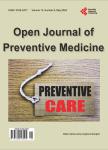Challenges and Adherence to Standard Precautions for Prevention of Percutaneous Injuries and Exposure to Blood Borne Pathogens in Clinical Practice: A Review
Challenges and Adherence to Standard Precautions for Prevention of Percutaneous Injuries and Exposure to Blood Borne Pathogens in Clinical Practice: A Review作者机构:Faculty of Medicine University of Nigeria Nsukka Nigeria University of Nigeria Teaching Hospital Enugu Nigeria
出 版 物:《Open Journal of Preventive Medicine》 (预防医学期刊(英文))
年 卷 期:2020年第10卷第8期
页 面:195-216页
学科分类:1002[医学-临床医学] 100214[医学-肿瘤学] 10[医学]
主 题:Percutaneous Injuries Prevention Standard Precautions Adherence
摘 要:Background: Standard Precautions (SP) was introduced by Centre for Disease Control to minimise the risks of disease transmission in the process of healthcare. Many factors are thought to influence the knowledge and the practice of these measures. Objective: To review challenges and adherence to SP for the prevention of percutaneous injuries and exposure to patients’ blood in clinical practice. Methods: The World Wide Web sites such as, Pub Med central, Google scholar were searched using key words such as percutaneous, needle stick injuries, standard precautions, adherence. Relevant articles were reviewed and included based on defined criteria. Results: The prevalence of needle stick injuries (NSI) varies among health care workers (HCWs) and across countries and is as high as 73% among some groups. The knowledge of SP varied among HCWs in different nations;however the practice of SP was noted to be lower than knowledge across most studies. Majority of HCWs in developing countries that sustained NSI failed to report the incident to appropriate authorities. Adherence to Standard Precautions is influenced by lack of proper training, poor supplies, low commitment of HCWs and health facility managers etc. Conclusion: Needle stick injuries and exposure to patients’ blood remain a risk for disease transmission among HCWs. Despite appreciable knowledge of standard precautions, the practice has remained low across the globe. Factors that had positive influence on practice of SP such as use of devices with safety features, adherence to infection control guideline, comfortable working environment, repeated and intense training etc. should be adopted and promoted.



